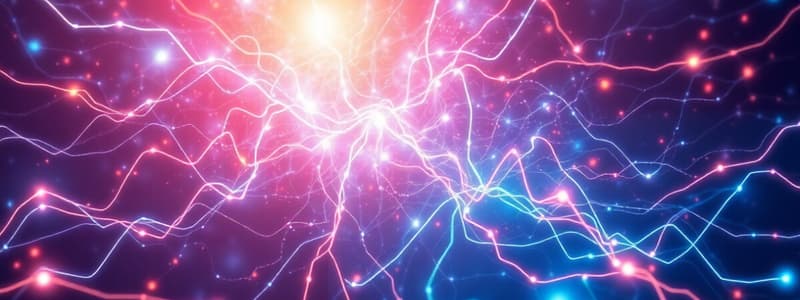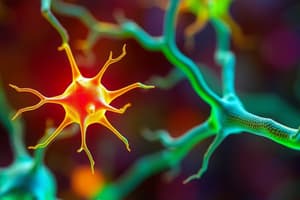Podcast
Questions and Answers
What is the primary role of the Nodes of Ranvier in saltatory conduction?
What is the primary role of the Nodes of Ranvier in saltatory conduction?
- To increase ATP production in neurons
- To decrease the number of ion channels in myelinated segments
- To facilitate faster transmission of electrical signals (correct)
- To generate action potentials in the axon
Which structure is primarily responsible for establishing a resting membrane potential of -70 mV?
Which structure is primarily responsible for establishing a resting membrane potential of -70 mV?
- Calcium ion channels
- Chloride leak channels
- Voltage-gated ion channels
- Sodium-potassium pump (correct)
Which statement best describes the difference between action potentials and graded potentials?
Which statement best describes the difference between action potentials and graded potentials?
- Graded potentials are local changes in membrane potential, while action potentials are all-or-nothing responses. (correct)
- Action potentials decrease in amplitude as they travel along the axon.
- Action potentials can vary in magnitude based on stimulus strength.
- Graded potentials are always initiated at the axon hillock.
What type of information do ascending tracts in the white matter of the spinal cord primarily carry?
What type of information do ascending tracts in the white matter of the spinal cord primarily carry?
If a neuron's membrane becomes more permeable to potassium ions, what effect would it have on the membrane potential?
If a neuron's membrane becomes more permeable to potassium ions, what effect would it have on the membrane potential?
Which component of a feedback loop is responsible for sensing changes in the environment?
Which component of a feedback loop is responsible for sensing changes in the environment?
What is the primary function of negative feedback in maintaining homeostasis?
What is the primary function of negative feedback in maintaining homeostasis?
During diffusion, what drives solutes to move down a concentration gradient?
During diffusion, what drives solutes to move down a concentration gradient?
Which of the following best describes facilitated diffusion?
Which of the following best describes facilitated diffusion?
What role does the myelin sheath play in action potential propagation?
What role does the myelin sheath play in action potential propagation?
In the context of selective permeability, which type of solute is likely to pass through a lipid bilayer easily?
In the context of selective permeability, which type of solute is likely to pass through a lipid bilayer easily?
Which type of transport requires ATP to move solutes against their concentration gradient?
Which type of transport requires ATP to move solutes against their concentration gradient?
Which physiological condition would most likely result from a loss of negative feedback in erythropoiesis?
Which physiological condition would most likely result from a loss of negative feedback in erythropoiesis?
What is the effect of competition in membrane transport?
What is the effect of competition in membrane transport?
Which type of neurotransmitter communication is characterized by signaling to adjacent cells through local mediators?
Which type of neurotransmitter communication is characterized by signaling to adjacent cells through local mediators?
What is the main factor affecting the rate of diffusion according to Fick's Law?
What is the main factor affecting the rate of diffusion according to Fick's Law?
Which statement accurately describes feedforward mechanisms in homeostasis?
Which statement accurately describes feedforward mechanisms in homeostasis?
Which of the following is NOT a type of receptor based on the location of the chemical messenger?
Which of the following is NOT a type of receptor based on the location of the chemical messenger?
Flashcards are hidden until you start studying
Study Notes
Nodes of Ranvier and Saltatory Conduction
- Nodes of Ranvier are gaps in the myelin sheath that allow for rapid conduction of action potentials, known as saltatory conduction.
- The action potential "jumps" from one node to the next instead of traveling along the entire axon membrane, which speeds up the transmission of signals.
Resting Membrane Potential
- The sodium-potassium pump is primarily responsible for establishing a resting membrane potential of -70 mV in neurons.
- This pump actively transports three sodium ions out of the cell for every two potassium ions pumped in, creating a net negative charge inside the cell.
Action Potentials vs. Graded Potentials
- Action potentials are all-or-nothing events with a fixed amplitude and duration, while graded potentials vary in amplitude and duration depending on the strength of the stimulus.
- Action potentials are typically used for long-distance communication, while graded potentials are used for short-distance communication.
Ascending Tracts in the Spinal Cord
- Ascending tracts in the white matter of the spinal cord carry sensory information from the body to the brain.
- This information includes touch, pain, temperature, proprioception, and other sensory modalities.
Potassium Permeability and Membrane Potential
- Increasing the permeability of a neuron's membrane to potassium ions would lead to hyperpolarization, making the membrane potential more negative.
- This occurs because potassium ions move out of the cell, following their concentration gradient and making the inside of the cell more negative.
Feedback Loop Components
- The receptor is responsible for sensing changes in the environment and initiating a feedback loop.
- It detects deviations from the set point and relay this information to the control center.
Negative Feedback and Homeostasis
- Negative feedback is a primary mechanism for maintaining homeostasis by counteracting changes in the internal environment.
- If a variable drifts too far from the set point, negative feedback mechanisms act to bring it back to the desired range.
Diffusion and Concentration Gradient
- The difference in concentration of a solute between two areas, known as the concentration gradient, is the driving force behind diffusion.
- Solutes move from areas of higher concentration to areas of lower concentration, attempting to reach equilibrium.
Facilitated Diffusion
- Facilitated diffusion is a type of passive transport that uses membrane proteins to facilitate the movement of solutes across the cell membrane.
- It does not require energy and follows the concentration gradient but requires specific carrier proteins.
Myelin Sheath and Action Potential Propagation
- The myelin sheath, a fatty insulating layer around axons, plays a crucial role in action potential propagation by increasing the speed of conduction.
- It acts as an insulator, preventing the loss of electrical signals and allowing for faster transmission of information.
Lipid Bilayer Permeability
- Nonpolar, hydrophobic solutes, such as lipids and small, uncharged molecules, can easily pass through the lipid bilayer of the cell membrane.
- The hydrophobic nature of the membrane allows for the movement of similar molecules, while polar, hydrophilic molecules require specialized transport mechanisms.
Active Transport
- Active transport is a form of membrane transport that requires ATP to move solutes across the cell membrane against their concentration gradient.
- It expends energy to transport molecules from a region of lower concentration to a region of higher concentration.
- Examples include the sodium-potassium pump and the proton pump.
Erythropoiesis and Negative Feedback Loss
- Loss of negative feedback in erythropoiesis, the process of red blood cell production, could lead to erythrocytosis, an abnormal increase in red blood cells.
- Without negative feedback, erythropoietin production would continue unchecked, leading to an overproduction of red blood cells.
Competition in Membrane Transport
- Competition in membrane transport occurs when different solutes compete for the same transporter protein.
- This can slow down the transport rate of the competing solutes.
Neurotransmitter Communication: Paracrine Signaling
- Paracrine signaling, a type of neurotransmitter communication, involves signaling to adjacent cells through local mediators.
- Neurotransmitters diffuse across the synaptic cleft and bind to receptors on nearby target cells.
Fick's Law and Diffusion Rate
- The main factor affecting the rate of diffusion according to Fick's Law is the concentration gradient.
- The larger the concentration difference, the faster the rate of diffusion.
- Other factors include the surface area available for diffusion, the distance over which diffusion occurs, and the permeability of the membrane.
Feedforward Mechanisms in Homeostasis
- Feedforward mechanisms in homeostasis are anticipatory responses that prepare the body for changes in the internal environment.
- They act to prevent deviations from set point by initiating actions before the change actually occurs.
Receptor Types: Location Based
- All receptors, regardless of the location of the chemical messenger, are classified based on the location of the receptor, not the chemical messenger.
- This classification includes intracellular receptors located inside the cell, plasma membrane receptors located on the cell surface, and nuclear receptors located within the nucleus.
Studying That Suits You
Use AI to generate personalized quizzes and flashcards to suit your learning preferences.




